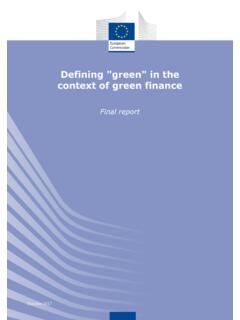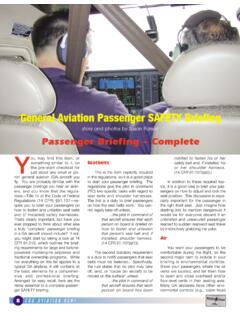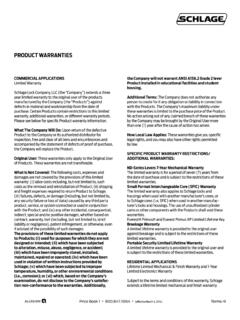Transcription of Beyond the Noise The Megatrends of Tomorrow’s World 1
1 1 The Megatrends of Tomorrow s WorldBeyond the NoiseThe Megatrends of Tomorrow s World32 The Megatrends of Tomorrow s WorldThe Megatrends of Tomorrow s WorldIntroduction 04 Drivers 08 Megatrends 82 Empowerment 84 Polarization 90 Hyperconnectivity 96 Disengagement 102 Aging 108 Dematerialization 114 Scarcity 120 Blurring Boundaries 126 Erosion of Governance 132 Displacement 138 Concluding Words 144 Sources 148 About the Authors 164 Contact 165 ContentHerausgeber: Deloitte Consulting GmbH2.
2 Auflage, Juli 2017 Alle Rechte , auch auszugsweise, Teil dieses Werkes darf ohne schriftliche Einwilligung des Verlages in irgendeiner Form (Fotografie, Mikrofilm oder ein anderes Verfahren), reproduziert oder unter Verwendung elektronischer Systeme verarbeitet, vervielf ltigt oder verbreitet werden. Deloitte Consulting GmbH, M nchen 2017 LOGOPUBLIX Fachbuch Verlag, M nchenSatz: Deloitte Design StudiosDruck: LOGOPRINT GmbH, M nchenISBN 978-3-927985-50-6 Die Deutsche Bibliothek verzeichnet diese Publikation in der Deutschen Nationalbibliografie. Detaillierte bibliografische Daten sind im Internet ber Megatrends of Tomorrow s World4We all have to make decisions in spite of an uncertain future.
3 Imagining the future through scenarios enables us to identify robust strategic choices that would fit to any plausible future, and to keep strategies flexible in case the future surprises us. Take a step back and consider this: is it easier to make assumptions about the future today, or some years back in the last millennium? Most people would agree that it is harder to make sense of it all today, compared to the more clear-cut and bipolar World in which we grew live in a World of ever faster tech-nology cycles, hyperconnected and nervously flickering financial markets, and post-factual politics. No wonder that the gentle art of perceiving, as scenario-pioneer Pierre Wack once famously described it, has become an increasingly critical skill when far- ranging decisions are to be this book, we would like to draw your attention to a number of trends that, in our current view, might well drive the future.
4 To do this, we will describe a selection of the social, tech-nology-related, environment-related, economic, and political drivers of change that we encounter again and again in our daily work at the Center for the Long View. There is one striking insight from years of scenario work: the set of driv-ers that form the general background to the scenarios we draw is surpris-ingly stable. It changes only slowly over time, and varies surprisingly little across industries, geographies and sectors. However, the ways in which these drivers link up and interact with Florian Klein Head of the Center for the Long View5each other is never the same, and is extremely specific to the focus of the scenario at hand.
5 In other words, drawing up a sensible list of factors that can explain the pro-verbial first 80 percent of our future is the easy bit of scenario thinking. Selecting the relevant drivers for your specific focal question, country or industry, and combining the overall set into plausible, balanced and chal-lenging stories, on the other hand, is an objective of this book is two-fold. We would like to give you a sense of structure when thinking about drivers of the future. By clustering drivers into buckets such as societal, tech-nology-related, environment-related, economic, and political (which is often referred to as the STEEP categoriza-tion), you are off to a good start. We would also like to open your eyes to the fact that the future is already here, you just need to perceive it.
6 After absorbing the list of drivers, you might start to read or watch the news differently. If you start to feel that most of the news we are bombarded with on a daily basis actually tie in neatly with one or several of the trends described in this book, you have started to think like a futurist. As you embark on your personal journey to imagine the future, please keep in mind two more points. First, this book can be read from front to back, but you don t have to stick to convention. Feel free to jump from driver to driver, go back and forth and explore the points that capture your imagination. Second, there are two parts to this book, and that structure needs a bit of explanation. The first section de-scribes 35 drivers of the future, which are social or political tendencies, economic or environment-related processes, or technological develop-ments we often rank as relevant when compiling our trend analyses.
7 These drivers certainly make an interesting read on their own, but they are still rather discrete and unrelated obser-vations between themselves. By contrast, the second section highlights Megatrends , which is a more abstract concept. Megatrends emerge at the intersection of two or three STEEP categories. For example, hyperconnectivity is a phenomenon that stems from both technology and society, and therefore qualifies as a megatrend. Yet, even more important-ly, Megatrends will have an impact on all aspects of our life in the future. To stick with our example, that mega- trend hyperconnectivity not only de-termines further future technologies and trigger new social trends, but also leaves its mark in politics, the envi- ronmental debate, and of course the economy.
8 To illustrate this, we provide five stories of the future for each megatrend, to give you examples of how the megatrend might impact the future across STEEP categories. Enjoy the Megatrends of Tomorrow s WorldThe Megatrends of Tomorrow s WorldThis century is best described as the era of the future of our World are 35 drivers of change. 98 The Megatrends of Tomorrow s World | DriversThe Megatrends of Tomorrow s World | Drivers89 SocietyTechnologyEnvironmentEconomyPolit icsBlockchain SystemsClimate ChangeAdditive ManufacturingTechnization of HealthcareAugmented RealityAutomationDemand for CustomizationDigitizationCloud TechnologyCompetition for TalentCrowd- sourcingData MonetizationGlobalizationIndustry ConsolidationDIY MovementEmpowered WomenFocus on TransparencyGeospatial TechnologyPolitical FragmentationRegulatory LandscapeInternet of ThingsKnowledge WorkerNext-Gen WorkforcePartnership ModelsResource Price VolatilityResource ScarcityArtificial IntelligenceConcentration of WealthEnvironmental
9 AwarenessMass MigrationSharing EconomySocial MediaSocial UnrestTerrorist OrganizationsUrbanization1110 The Megatrends of Tomorrow s World | DriversThe Megatrends of Tomorrow s World | DriversSources: Deloitte University 2017 Path I: Stasis Strategic imperative: Performance Value driver: Profit with a cost focus Key enabling AM capabilities: - Design and rapid prototyping - Production and custom tooling - Supplementary or insurance capability - Low rate production/no change overPath II: Supply chain evolution Strategic imperative: Performance Value driver: Profit with a cost focus, and time Key enabling AM capabilities: - Manufacturing closer to point of use - Responsiveness and flexibility - Management of demand uncer- tainty - Reduction in required inventoryPath III: Product evolution Strategic imperative: Balance of growth, innovation, and performance Value driver: Balance of profit, risk, and time Key enabling AM capabilities: - Customization to customer requirements - Increased product functionality - Market responsiveness - Zero cost of increased complexity Path IV: Business model evolution Strategic imperative: Growth and innovation Value driver: Profit with revenue focus, and risk Key enabling AM capabilities.
10 - Mass customization - Manufacturing at point of use - Supply chain disintermediation - Customer empowermentHigh product changeNo product changeHigh supply chain changeNo supply chain changeFramework for understanding AM paths and potential valueImportance AM already affects an enormous number of industries including automotive, industrial products, medical devices, aerospace and defense, consumer goods, and architecture. From 2013 to 2018, the market volume for AM systems and sup- port products/services is expected to rise from US $ billion to US $ billion. The fastest growing segment within AM, metals, is expected to reach a market volume of US $ billion by 2025. AM is currently already used in some form in 24% of manufacturing firms and in up to 50% of supply chain leaders.













